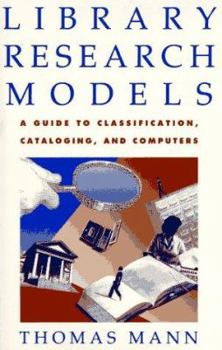Library Research Models: A Guide to Classification, Cataloging, and Computers
Select Format
Select Condition 
Book Overview
Most researchers, even with computers, find only a fraction of the sources available to them. As Library of Congress reference librarian Thomas Mann explains, researchers tend to work within one or another mental framework that limits their basic perception of the universe of knowledge available to them. Some, for example, use a subject-disciplinary method which leads them to a specific list of sources on a particular subject. But, Mann points out,...
Format:Hardcover
Language:English
ISBN:0195081900
ISBN13:9780195081909
Release Date:September 1993
Publisher:Oxford University Press, USA
Length:264 Pages
Weight:1.05 lbs.
Dimensions:1.0" x 5.8" x 8.6"
Customer Reviews
5 ratings
Useful and well-written
Published by Thriftbooks.com User , 14 years ago
I'm sure I can't tell you anything new about Thomas Mann, so I'll give you my take. This book was recommended to me by one of my professors in library school. Within pages, you will have insights into patron behavior that you never had before, and this will help you develop strategies for dealing with it. If you've got the time, delve into the bibliography and additional reading recommendations. Well worth it. You'll want to buy it, not borrow it. The information is dense and invaluable, and you'll refer to it regularly.
Good deal
Published by Thriftbooks.com User , 15 years ago
Got this book for college, half the price of the college bookstore. Arrived in perfect shape by mail within 3 days. No complaints.
Should be a required text in library school.
Published by Thriftbooks.com User , 18 years ago
I just finished reading Thomas Mann's Library Research Models: A Guide to Classification, Cataloging, and Computers (New York: Oxford University Press, 1993). It is an outstanding book, one I recommend for all library students and librarians. I wish my reference professor had assigned this as a text! Mann, who is currently (as far as I know) a reference librarian at the Library of Congress, describes a number of different library research models, including: specific subject or discipline model, traditional library science model (classification scheme, vocabulary-controlled catalog, published bibliographies and indexes), type-of-literature model, actual-practice model, and computer workstation model. He notes the limitations and powers of each approach, and he concludes the book with a cumulative methods-of searching model that uses most of these models to account for the weaknesses of the others. If you want a comprehensive approach to your next massive research project, Mann provides it! Along the way, he made a number of excellent arguments. The first is that most people believe that the organization of information in the library consists of the classification scheme alone. Thus, people assume the only way to access the information in a library is to find the call number or class where a certain subject might be and browse around that area in the stacks. Unfortunately, this is a deficient assumption. As Mann and critics of classification schemes point out, one book can address many subjects. So, where does a book go then? Similarly, a book addressing one subject can address many different aspects of it. Which aspect should be be brought out in its class assignment? Given these probelms, a person browsing the stacks may be missing several relevant books if he or she restricts the search to one class area in the stacks. Nevertheless, classification is important, as it provides a library user access to the full text of the library's collection. Mann provides examples of information that cannot be found through a library's catalog or various bibliographies and indexes, but only through browsing in the book's of a library's collection. Another argument he makes is the controlled vocabulary used in the library's catalog is a powerful mechanism for providing access to information. Specifically, controlled vocabulary provides predictability and serendipity. Yes, that's right. Mann provides innumerable examples to show this. He rightly criticizes information scientists who insist that keyword/postcoordinate searches have made controlled vocabulary irrelevant. "Tagging" has become popular. However, tagging lacks authority control and the syndetic structure of thesauri and books of subject headings, such as the Library of Congress Subject Headings, and thus lacks the full predictability of formal controlled vocabularies. Mann describes another aspect not emphasized in research or in library science education: the importance of bibliographies and index
If you don't know the "red books" you're missing the boat
Published by Thriftbooks.com User , 24 years ago
Dr. Mann (who has a Ph.D. in English and worked as a private investigator at one time) is a senior reference librarian at the LoC and knows his stuff. If you need serious help stop by the main reading room on Weds. nights and you'll likely find him. The book is very good but his personal knowledge is even better!
Not comprehensive as title indicates, but worth reading
Published by Thriftbooks.com User , 27 years ago
Most interesting to me was the author's assertion that digitalization of books adversely affects their preservation, due to the evanescent nature of computer software and hardware standards. A book printed 500 years ago is still readable today. Could the same be said for a CD-ROM 500 years from now





